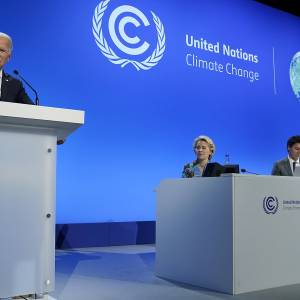
Climate change and health are closely connected, with the risks of a warming world and inadequate climate policies posing significant mental and physical health risks across Australia. If identified health concerns remain relatively unaddressed, and greenhouse gas emissions continue, it is expected that Australian life will be fundamentally altered, and that these alterations will pose significant long-term costs for governments and individuals.
Key takeaways:
- Emerging health concerns stem particularly from frequently hotter days, rising temperatures and shifting weather pattern due to inadequate policies surrounding greenhouse gas emissions.
- One of the most problematical issues is the escalating occurrence and sheer number of displaced persons or climate refugees both domestically and internationally, leading to significant psychological issues as well as difficulties in supply chain and food or water accessibility.
- Changing weather patterns can also be strongly linked to the spreading of disease and illness through animals, insects and shifting air and water patterns.
- Asthma and respiratory issues also becoming increasingly worrying, as admissions to emergency departments are heightened through events such as bushfires and thunderstorms, severely impacting air quality and causing long-term health problems.
Are Australia’s current responses and commitments to climate policies sustainable and, what measures should Australia put in place to better prepare health systems?
Should further support be provided to farmers and those in agriculture following natural disasters, to maintain support for supply chains and mental health in the events of crop destruction or water inaccessibility?
How can Australia appropriately address domestic mental health issues influenced by climate change, such as correlations between warmer climates and domestic violence/ aggression?
Should Australia be expected to take on the health burdens of neighbouring countries (Pacific Islands, etc.), in relation to food or water supply shortages and mass migration?
The earth’s climate and human health are intrinsically linked, with rising greenhouse gas emissions inflicting clear repercussions on physical and psychological wellbeing. Australia’s average temperate has risen by over one degree since 1910, a shift which has already led to severe consequences across our health systems (CSIRO, 2018). Climate scientists and healthcare professionals have found underlying correlations between heightened frequency and severity of hot weather, disaster events and shifting rainfall patterns to air pollution, disease and illness, cardiovascular and respiratory issues, water quality, food supply and distribution, premature death and injury, mental health, suicide rates and domestic violence and behaviours (Padhy et al., 2015). As the Australian government and international counterparts fail to effectively combat climate change and make amendments to meet commitments and targets, emerging health concerns will continue inflating, affecting global and Australian citizens for generations (Climate Action Tracker, 2021; Morton, 2021).
A core trend linked to rising temperatures is the aggravation of respiratory illnesses, particularly asthma and allergies (D’Amato et al., 2015). Asthmatics are particularly vulnerable, with 300 million people affected globally, as warmer weathers encourage flowers to bloom earlier and for extended periods, circulating escalating amounts of pollen (Nunes et al., 2017). Shifting wind patterns and natural disasters spread pollens or other particles into new regions or countries and reduce air quality (D’Amato et al., 2020). Victoria’s 2016 thunderstorms caused a 3000 percent increase in asthma hospital admissions to intensive care (Victoria State Government, 2017). Extreme heat conditions can also be correlated to heart failure, stroke, and cardiovascular mortality due to heightened sweating and altered blood circulation (Cui, 2014).
Researchers have also founded that a warming world will cause the spread of diseases and illness across the globe through shifting air and water conditions or transmitted through insect or animal migration (World Health Organisation, 2018). A developing concern is the expected migration of mosquitos across the planet, spreading deadly diseases such as malaria, dengue fever, West Nile virus and chikungunya (Jordan, 2019).
Studies have also revealed alarming connections between climate change and aggressive behaviour, with extreme heat or disaster leading to the increased consumption of alcohol, and an attributing increase in domestic violence, hospital admissions for mental health and suicide (Morganstein, 2019). Heat waves are also associated with increased anxiety, mood disorders, dementia, and psychological exhaustion (Padhy, 2015).
Scientists have also found strong correlation between climate change and aggressive behaviours, with extreme heat or disasters leading to the increased consumption and binging of alcohol, and attributing increases in domestic violence reports, hospital admissions for mental health and suicides (Morganstein, 2019). Heat events can also be associated with increased anxiety, mood disorders, dementia, and psychological exhaustion (Padhy, 2015).
Between 1980-2018 natural disasters rose from 3.9 to 6.5 events annually, with these events damaging crops, encouraging soil subsidence, land degradation and drastically altering supply chains (Refer to Appendix A & B; Moss & Burkett, 2020). These impacts have caused millions to migrate from homes and become displaced persons instigating surging mental health conditions around anxiety, post-traumatic stress, depression, and heightened suicide rates (Podesta, 2019). Surging disasters and heatwaves have a particularly adverse effect on farmers as extreme weather events destroy crops and create financial hardships, leading to surging levels in suicide attempts amongst farmers and those in rural communities (Berry, 2011).
Migration is expected to become an increasingly occurrent event exacting severe mental health ramifications, with long-term climate change impacts surrounding food scarcity, air and water quality, shifting weather and environments and loss of employment (McMichael, 2013). Since 2008 it is reported that 20 million on average are forced out of areas globally due to shifting weather patterns and disaster, these numbers are expected to reach between 25 million to 1 billion by 2050 (Oxfam, 2019; Brown, 2008). Displaced persons due to climate change are likely to experience a strong psychological toll, forced to leave residences and facing extreme inequalities in many cases on living situations (Brown, 2008).
Earth’s warming climate poses sweeping implications for human health, with volatile rainfall patterns, air and sea temperatures, rising sea levels and increasingly frequent and severe natural disasters all posing evolving threats to wellbeing. Climate health impacts can be mapped as exceedingly broad, as effects range across physical and mental health both directly and indirectly (Cianconi et al., 2020).
Australia has signed onto meeting international targets intended to reduce greenhouse gas emissions through the Paris Agreement and Kyoto Protocol. However, if international commitments remain largely ignored by Australian and international governments, and if policies are not implemented surrounding the health impacts of emission intensive industries, unmitigated greenhouse gas emissions and corresponding climate effects could intrinsically alter Australian health and lifestyle (Australian Academy of Science, 2021). Unmitigated emissions could instigate increased and severe mental health issues, heightened suicide rates, asthma and allergies, illness and disease, respiratory and cardiovascular problems, premature death and injury, malnutrition and food distribution and water and air quality (McMichael et al., 2003). These impacts are already well in effect and, as Australia continues on a path to bypass established targets, these health risks are becoming increasingly prevalent and irreversible with the Morrison government resorting to using the pandemic to justify expanding gas basin developments and proposed gas generation projects (Climate Action Tracker, 2020).
Initiating comprehensive counter measures are in the best interest of the Australian government, Australian citizens, and national healthcare response systems, with extreme heat and corresponding fatigue costing the economy an estimated $8 billion annually, expected to cause several thousand additional deaths across the nation by 2050 (Horsburgh et al., 2017). Unmitigated climate change is also set to pose significant issues to the mental health and behaviour of Australians, leading to increased aggression and domestic violence, vulnerability to climate disasters, suicide attempts and anxieties due to displacement or becoming climate refugees (Hughes & McMichael, 2011; Berry et al., 2010). Australia is particularly vulnerable in this context, as heat events have proven to have direct correlation to suicide, particularly impacting farmers, and those in rural areas, potentially also impacting Australia’s agriculture industry and food supply/distribution (Berry, 2011).
Climate scientists propose that to target and prevent the inflammation of identified health risks, our international agreements must be met, as well as correlating policy actions surrounding; ‘health promoting and emissions, emergency and disaster preparedness, supporting healthy and resilient communities, education and capacity building, leadership and governance, sustainable and climate resilient health sector and research and data’ (Horsburgh et al., 2017).
References
Australia Academy of Science. (2021). The Risks to Australia of a 3 Degree Warmer World. Retrieved 10 May, 2021 from https://www.science.org.au/files/userfiles/support/report-and-plans/2021/risks-australia-three-deg-warmer-world-report.pdf
Baaghideh, M., Mayvaneh, F. (2017). Climate Change and Simulation of Cardiovascular Disease Mortality: A Case Study of Mashhad, Iran. Iranian Journal of Public Health, 46 (3): 396407. PMID: 28435826; PMCID: PMC5395536.
Berry, H.L., Bowen, K.J., Kjellstrom, T. (2010). Climate change and mental health: A causal pathways framework. International Journal of Public Health, 55(2):123-32. DOI:10.1007/ s00038-009-0112-0
Berry, H.L., Hogan, A., Owen, J., Rickwood, D. (2011). Climate Change and Farmers’ Mental Health: Risks and Response. Asia-Pacific Journal of Public Health, 23(2):119S-32
Brown, O. (2008). Migration & Climate Change. International Organisation for Migration Geneva. Retrieved May 10, 2021
Cianconi, P., Betro, S., Janiri, L. (2020). The Impact of Climate Change on Mental Health: A Systematic Descriptive Review. Systematic Review, 11 (94). https://doi.org/10.3389/fpsyt.2020.00074
Climate Action Tracker. (2020). Australia. Pledges & Targets. Retrieved May 10, 2021 from https://climateactiontracker.org/countries/australia/pledges-and-targets/
CSIRO. (2018). Australia’s Changing Climate. Retrieved May 10, 2021 from https://www.csiro.au/en/research/environmental-impacts/climate-change/state-of-the-climate/previous/state-of-the-climate-2018/australias-changing-climate
CSIRO. (2020). Climate Change in Australia. Retrieved May 5, 2021 from https://www.csiro.au/en/research/environmental-impacts/climate-change/climate-change-information
Cui, J., Sinoway, L. I. (2014). Cardiovascular responses to heat stress in chronic heart failure.
Curr Heart Fail Rep, 11(2): 139–145. doi: 10.1007/s11897-014-0191-y
D’Amato, G., Baena-Cagnani, C.E., Cecchi, L., Annesi-Maesano, I., Nunes, C., Ansotegui, I., D’Amato, M., Liccardi, G., Sofia, M., Canonica, W.G. (2013). Climate change, air pollution and extreme events leading to increasing prevalence of allergic respiratory diseases. Multidisciplinary Respiratory Medicine, 8 (12). https://doi.org/10.1186/2049-6958-8-12
D’Amato, G., Chong-Neto, H.J., Ortega, O. P. M., Vitale, C., Ansotegui, I., Rosario, N., Haahtela, T., Galan, C., Pawankar, R., Murrieta-Aguttes, M., Cecchi, L., Bergmann, C., Ridolo, E., Ramon, G., Dias, S. G., D’Amato, I., Annesi-Maesano, I. (2020). The effects of climate change on respiratory allergy and asthma induced by pollen and mold allergens. European Journal of Allergy and Clinical Immunology, 75 (9): 2219-2228. https://doi. org/10.1111/all.14476
Horsburgh, N., Armstrong, F., Mulvenna, V. (2017). Framework for A National Strategy on Climate, Health and Well-Being for Australia. Climate and Health Alliance. Retrieved May 10, 2021
Hughes, L., McMichael, T. (2011). The Critical Decade: Climate Change & Health. Climate Council. Retrieved May 10, 2021 from https://www.climatecouncil.org.au/uploads/1bb6887d6f8cacd5d844fc30b0857931.pdf
Jordan, R. (2019). How does climate change affect disease? Stanford University. Retrieved May 10, 2021 from https://earth.stanford.edu/news/how-does-climate-change-affect disease#gs.0llsya
Leonard, J. (2020). How does climate change affect human health? Medical News Today. Retrieved May 5, 2021 from https://www.medicalnewstoday.com/articles/climate-change-and-health#public-health
McMichael, A. J., Campbell-Lendrum, D. H., Corvalan, C.F., Ebi, K. L., Githeko, A.K., Scheraga, J.D., Woodward, A. (2003). Climate change and human health. Risks and Responses. World Health Organisation. Retrieved 10 May, 2021
McMichael, C. (2013). Climate Change and Migration: Food Insecurity as a Driver and Outcome of Climate Change-Related Migration. DOI:10.1007/978-94-007-7890-0_12
Morganstein, J.C. (2019). How Extreme Weather Events Affect Mental Health. American Psychiatric Association. Retrieved May 10, 2021 from https://www.psychiatry.org/patients-families/climate-change-and-mental-health-connections/affects-on-mental-health
Morton, A. (2021). Australia needs to cut emissions by at least 50% by 2030 to meet Paris goals, experts say. The Guardian. Retrieved 12 May, 2021 from https://www.theguardian.com/australia-news/2021/jan/28/australia-needs-to-cut-emissions-by-at-least-50-by-2030-to-meet-paris-goals-experts-say
Moss, J., Burkett, D. (2020). Climate Transitions Series: Social Justice and the Future of Fire Insurance in Australia. UNSW. Retrieved May 5, 2021 from https://climatejustice.co/wp-content/uploads/2020/05/The-Future-of-Fire-Insurance-in-Australia-2.pdf
Nunes, C., Pereria, A.M., Morais-Almeida, M. (2017). Asthma costs and social impact. Asthma Research & Practice, 3 (1). doi: 10.1186/s40733-016-0029-3
Oxfam. (2019). Forced from home: climate-fuelled displacement. Retrieved 10 May, 2021 from https://www.oxfam.org/en/research/forced-home-climate-fuelled-displacement
Padhy, S.K., Sarkar, S., Panigrahi, M., Paul, S. (2015). Mental health effects of climate change. Indian Journal of Occupational & Environmental Medicine, 19 (1): 3-7. doi: 10.4103/0019- 5278.156997
Parise, I. (2018). A brief review of global climate change and the public health consequences.
Clinical, 47 (7). Doi: 10.31128/AJGP-11-17-4412
Ryan, R.G., Silver, J.D., Schofield, Robyn. (2021). Air quality and health impact of 2019–20 Black Summer megafires and COVID-19 lockdown in Melbourne and Sydney, Australia. Environmental Pollution, 274 (1). https://doi.org/10.1016/j.envpol.2021.116498
Victoria State Government. (2017). The November 2016 Victorian epidemic thunderstorm
World Health Organisation. (2018). Climate Change & Health. Retrieved May 5, 2021 from https://www.who.int/news-room/fact-sheets/detail/climate-change-and-health






